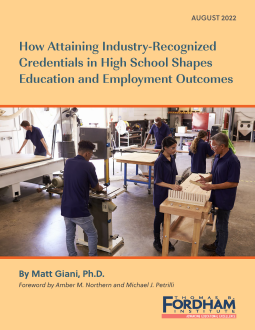Shaping Education and Employment
How Attaining Industry-Recognized Credentials in High School Shapes Education and Employment Outcomes
Conferred by businesses, industry groups, and state certifying entities, industry-recognized credentials (IRCs) are intended to signal that students have mastered specific workplace knowledge and skills.
This first-of-its-kind study assesses the impact of specific IRCs earned in high school on various employment and postsecondary outcomes for students who do and do not attend college. The findings can help education leaders and policymakers improve CTE and IRC opportunities in order to boost student success in the labor market.
To read the full report and its implications for educational leaders and policymakers, scroll down or download the PDF (which includes the appendices).
Shrinking Student Body
Recent statistics show that 685,000 fewer students were enrolled in undergraduate programs (both community colleges and four- year institutions) in spring 2022 than the previous spring. That’s a drop of 4.1 percent—steeper than the 3.5 percent decline the previous spring. To date, the college student body has shrunk by nearly 1.4 million or 9.4 percent during the pandemic.
One reason is that younger Americans, for better or worse, are starting to question the value of college. Among those with a bachelor’s degree or more, just 56 percent under age thirty think the benefits of their education exceed the cost. That compares with 82 percent of those age sixty or over.
While postsecondary education obviously remains valuable for students’ career prospects, escalating tuition costs—coupled with many young people saying they aren’t learning job-ready skills—means that we need to do a much better job preparing both students who choose to go straight into the labor market after high school and those headed to college. One way that high schools can respond to increasing demand for career preparation is by helping their students attain industry-recognized credentials (IRCs).
Industry-Recognized Credentials (IRCs)
These are credentials conferred by businesses, industry groups, or state certifying entities to individuals who demonstrate a sufficient level of knowledge and skills in a particular domain, often through one or more assessments. For instance, the American Welding Society (AWS) issues several different types of welding certifications pertaining to inspection, engineering, education, and sales.
Students earn IRCs most often through career and technical education (CTE), including “concentrating” in several related CTE courses. Some want an IRC, or at least its content, for personal reasons—so they can repair their own car, cook for their family, or even flip houses one day. Others see a high school IRC as part of a stack of credentials to be accumulated, a stack that may include some (or a lot of) college and additional vocational and technical instruction.
But the most straightforward reason for a high school IRC is to advance one’s prospects in the workforce. Yet we know almost nothing about whether IRCs better equip high school graduates to gain employment and earn a living wage. Neither do we know whether IRCs earned during high school make it likelier that students will build upon them when choosing college majors.
Source:
https://www.techedmagazine.com/category/news/


